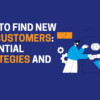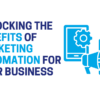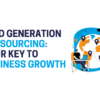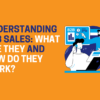What Is Account Based Marketing?
Account Based Marketing (ABM) is a business marketing technique that focuses resources on a limited number of target customers within a particular industry. Personalised campaigns are developed for these targeted accounts to connect with an account based on the marketing message and the account’s requirements.
Beyond lead generation, Account Based Marketing takes a more systematic approach to marketing. One of the keys to extracting the most value from the biggest customers is marketing to current customer accounts to promote upselling and cross-selling.
Benefits Of ABM
For B2B companies that approach larger accounts, account-based marketing is becoming increasingly common. Account Based Marketing has many advantages over other marketing methods for businesses looking to sell into big accounts with lengthy sales times and large deal sizes. They are as follows:
Fewer Resources Squandered
Time and money are concentrated on a limited number of accounts with the highest likelihood of closing sales. This maximises the use of resources that would otherwise be squandered.
Return On Investment
Account-based marketing is accurate and measurable, with the greatest return on investment of any B2B marketing strategy. Account-based marketing, according to 85% of marketers who monitor ROI, generates higher returns than any other marketing strategy.
Combination Of Sales And Marketing
Account-based marketing allows marketing and sales teams to collaborate on defining target customers, creating personalised strategies for them, and aligning and moving individual accounts across the process before and after customer conversion.
Effective Sales Process
Multiple stakeholders are interested in big purchasing decisions. Since it begins at a lower level in the company and progresses progressively towards the primary decision-maker, this usually slows down the sales cycle. The length of the period is reduced in account-based marketing since all targets are nurtured at the same time.
Approach Is Personalised
Multiple stakeholders are interested in big purchasing decisions. Since it begins at a lower level in the company and progresses progressively towards the primary decision-maker, this usually slows down the sales cycle. The length of the period is reduced in account-based marketing since all targets are nurtured at the same time.
The TLGC Account Based Marketing Cycle
With Account Based Marketing, it’s more streamlined than a sales cycle. Focusing our efforts on specific high-value target accounts can save time and resources which means we can spend more time on the stages that positively impact your bottom line. ABM ensures your target accounts are ideal for your business so you can quickly dive into building relationships.

Identify Target Accounts.
Present personalised campaigns to the target accounts.
Close the target account and convert into a new customer.
Delight your target account.
Account Based Marketing Examples
Account-based marketing starts with the creation of relevant segments followed by the identification of marketing campaigns that can be tailored to those segments on the networks that have the greatest effect on them (events, website, email). Each company’s plan will use a unique combination of tactics. Your strategy for targeting a specific account will be determined by the account’s unique characteristics, meaningful categories, and related marketing channels. The target segments for your account based marketing programs would be those that will provide the most value to your business. Here are some real-world examples of how B2B companies may use account-based marketing to build their campaigns:
Direct Mail
Direct mail has become a common method of reaching prospects inside an organisation in an era where everyone is swamped with email. Since ABM is more focused, direct mail rewards and ads can be more valuable because the sales potential is much higher.
Email Campaigns
Email remains an important marketing channel for ABM, despite the popularity of direct mail. Unlike volume-based marketing, which can employ templates and marketing automation, account-based marketing entails customising email messages for each organisation and person.
Paid Advertising
PPC and paid social media advertising are common ways to approach specific accounts on the internet. Social media sites like LinkedIn and Facebook enable you to reach specific businesses and personas and show campaigns that can be targeted to concentrate on a small number of target accounts through technology such as retargeting and IP targeting rather than spreading a large net.
Events
Sales teams have often found that in-person activities are one of the most effective ways to convince decision-makers. Specific invites to key prospects from target accounts, exclusive VIP dinners, customized gifts and free products for target accounts, and tailored follow-up after the event are all examples of an account based marketing approach to events.
Webinars
Webinars, like events, can be personalised to be appropriate and timely for a particular target account. Webinars and follow-up can be personalized for particular businesses, and custom webinar content can be produced with the target audience in thought.
Personalisation On Website
On the internet, account based marketing campaigns go beyond driving traffic with customised search engine marketing and inbound marketing campaigns. When visitors arrive at the website, website personalised technologies can be used to provide a unique, account-specific interaction for target prospects rather than the generic website experience.
How to Put Account Based Marketing in Place
- Determine which accounts are of high importance to you.
These are the main accounts that have the greatest potential to improve the company’s sales. Begin your account-based marketing efforts by identifying the common characteristics of the organisations that generate the most MRR (monthly recurring revenue) for your company. For example, for the accounts that are producing your business the highest long-term income, identify the market, company size, area, annual sales, upsell potential, profit margin, and so on. Those are the kinds of accounts you can target.
Quantitative and qualitative analysis will most likely be used in this method. For example, collaborating with strategic leaders and customer-facing employees in your sales and customer success departments to benefit from their experiences while also finding evidence to back up these conclusions. Employees, who operate on the front lines of potential customers will provide incredibly useful information through this period, because who knows the leads and sales better than they do? With the data to back it up, you’ll be on your way to revenue in no time. This is a vital step because if you don’t clearly identify your target, you won’t be able to move on to the next step.
- Conduct an investigation into those accounts.
Next, it’s time to go commercial hunting with some of the sales team’s innovative thinkers. If you’ve figured out who the main stakeholders are of the organisations you’re interested in, you’ll need to identify the ones that fit your criteria.
The main elements of this phase are understanding more about how decisions are made at these target accounts, deciding who the decision-makers are, and knowing more about how decisions are made once you’ve established some target organisations. When it comes to account-based marketing, information is true strength. Put on your detective hat and start learning about the internal workings of these businesses, then develop a strategy for how you can persuade the stakeholders at each one.
- Create tailored marketing strategies.
Create innovative assets that will align with the target account, based on the knowledge you collected during the research process. It’s now time to put your investigative expertise to use by producing content that appeals directly to these stakeholders and organisations. You should be aware of these stakeholders’ individual specific problems and appeal to how your wording and illustration can alleviate them.
Keep in mind that the benefit of account-based marketing is that it’s tailored to these businesses, which is why your content should be targeted to them directly. Work with the design team and sales to make sure the content is not only visually pleasing but also conveys the right messages to these main stakeholders.
- Select the Most Effective Locations for Your Campaigns.
If you don’t promote your campaigns and are innovative in the right ways, your analysis and content will be ineffective. You need to know where these stakeholders go online and what they’re thinking about when they’re on social networking sites like Facebook, Instagram, and LinkedIn.
For example, if you’re targeting somebody in a graphic design company, you might already know that they spend time on Pinterest based on your preliminary research. If you’re targeting financial executives, you’d be smarter targeting them with Google Display advertising on Bloomberg, Market Watch, and Motley Fool.
Since you can run campaigns to cater to particular entities as well as titles within those organisations, Facebook and LinkedIn can be effective channels for targeting these stakeholders.
- Execute Your ABM Campaigns.
It is now time to physically run your campaign. You shouldn’t just let your imagination run crazy with your content. Here are a few things to remember: Since this form of marketing is so targeted, it’s crucial not to confuse these targets by sending them the same message over and over again via various channels. Make sure you’re not exploiting your remarketing capabilities by repeatedly sending the same message to the same people.
Also, make sure the networks aren’t set up to just communicate with one or two people at these companies. Remember that you’re going after a company and its stakeholders, not a single individual. You must find a balance between grabbing your prospect’s focus and shutting them off. No one enjoys being hassled by a salesperson.
- Measure the effectiveness of your personalised marketing strategies.
It is time to measure and evaluate the effectiveness of your account-based marketing efforts. Ask some critical questions. Don’t get disappointed if your results aren’t as good as you planned the first time. The great thing about online marketing is that the metrics are observable, allowing you to see precisely where you need to grow and develop.
Personalisation And Account Based Marketing
Customisation of a website is a vital aspect of an ABM strategy because it helps you to modify the creative and advertising on a website to each of your target accounts. The impression that visitors have once they enter the site can be tailored by website personalisation in the same way that offsite marketing campaigns are personalised for each account.
Web personalisation for ABM is accomplished by identifying unknown visitors to your site using firmographic data obtained by reverse IP lookups, first-party or third-party data. If the visitor’s business has been detected, they can be matched to your target account list for a more customised web experience.
Messages, videos, calls-to-action, and social evidence are only a few of the elements of a website that can be customised using account-based personalisation. Some examples of customised content from real-world scenarios are as follows:
- Differences in calls to action for individuals
- Unique market segments (prospects vs. customers)
- Targeting unique segments with tailored content variations
- Greeting with your first name or the name of your company
- Industry-specific personalised character images and headlines
Make Account Based Marketing Work For Your Business
We can work on behalf of your business by taking the time to build trusting relationships with these high-value accounts which will, in turn, expand your company and positively impact your bottom line.
Additionally, as we will personalise each communication with your high-value prospects this will create loyalty for your business over time and loyal customers.
Having loyal customers is your best asset as they will promote you and become brand advocates through referrals, networking and testimonials.
Contact us today and we can discuss the best Account Based Marketing tactics we can provide for YOU.





















